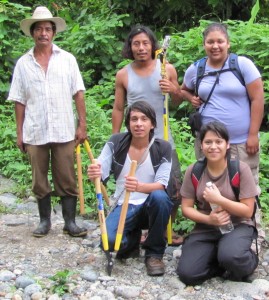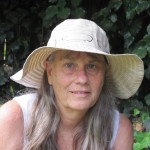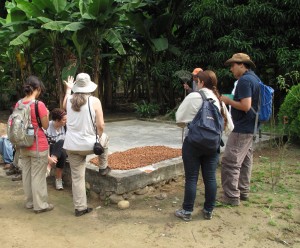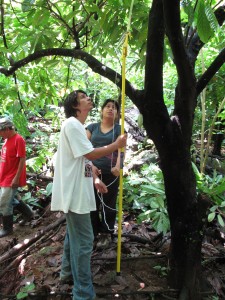Many students at California State University, Dominguez Hills spend their summers in various internships in a diversity of fields. Not that many students at the metropolitan institution, however, can say they had the opportunity to work on a rural chocolate farm in Mexico.

In June, associate professor of anthropology Janine Gasco took students in her Introduction to Mesoamerican Ethnoecology class on a two-week excursion to the Soconusco region of Chiapas, Mexico, for a look at local agriculture. In collaboration with a local nonprofit, La Red Maya de Organizaciones Orgánicas (CASFA), Gasco and her students assisted the area’s cacao farmers and studied the methods and culture in which they grow a product famous among chocolate makers worldwide, and whether or not their farming practices were sustainable.
During their trip, Gasco’s class had a unique opportunity to witness CASFA’s efforts to teach cacao farmers how to monitor their cacoa trees for signs of the deadly fungus monilia, and the painstaking maintenance that it would take to prevent em from losing entire orchards.
“We were able to see how people responded to the new tools, plus we were there to help them to go out and actually use the tools,” Gasco says. “A byproduct for the interest of the class was to see how people reacted to new ideas. Some farmers would literally say ‘Thank you very much’ for the tool, go put it in a corner of their house, and then take us out to their field with their machete. And others… saw in a minute why this was going to help. We did see some entire orchards that had been pulled up because [they were] infected. It’s going to be interesting in the long run because some farmers are not going to take the advice and they’re going to lose everything.”

Gasco says that the methods that CASFA is trying to introduce involve “radical changes for [farmers]. Traditional farmers everywhere are really suspicious of outsiders coming in and telling them what to do.” The nonprofit is encouraging the cacao farmers to begin watching their trees for signs of monilia, removing infected pods before the disease can spread, and pruning the trees to allow more sunlight in the orchards which would prevent the fungus from developing in a dark, humid atmosphere.
Another lesson that Gasco’s students took away from their trip was being afforded a glimpse of daily life among the farmers in Soconusco, which despite the poverty in some villages, was self-sustaining and afforded the visitors great hospitality.
“It was a whole cultural experience,” says Gasco. “We’d work in the cacao orchards, then they would take us back to their houses and feed us. So we got the chance to interact with the whole family, to see how a household works, and how different the houses were. We would get a sense of their lifestyle, their socioeconomic status, and how many people lived in the household. One family [had] a truck, a washing machine, and a stove. Another family had just a few light bulbs and no bathroom. They didn’t have anything electronic and cooked over a wood stove.”

“People eat what they grow. Even really poor families eat well; we would have these amazing banquets. Nobody’s starving there because things grow like crazy. A few extra people show up for breakfast and [they say], ‘Tell the kids to get a few more eggs from the chicken,’ ‘Go cut up a chile and we’ll make some salsa.’ It was really neat to see how you could put together a meal with what they had around the house.”
Gasco has worked with cacao farmers in Soconusco, Chiapas, Mexico to connect them with chocolate makers, most notably Askinosie Chocolate of Springfield, Mo. She has confidence that the ability of manufacturers to know the source of crops like cacao, vanilla, coffee, and tropical fruit holds great cache for niche markets.
“Every chocolate maker knows about Soconusco cacao because historically, it was the best chocolate,” she says. [Trade] is so undeveloped there because there is no infrastructure for marketing and there aren’t a lot of middlemen who are experienced in exporting. I’m just hopeful that… there’ll be other chocolate makers who are interested in having relationships with the actual farmers and meeting them and knowing exactly where the cacao is coming from.
“I came back very optimistic because there really is a growing interest internationally where you are supporting local farmers and organic production, both for your own health, the health of the farmers and the health of the earth. It’s a small thing but I think it’s growing.”
John Garcia, a junior majoring in Chicana/o studies, says that the visit to Soconusco gave him an appreciation for what life must have been like for his ancestors’own rural existence.
“My grandfathers also lived off the land in Zapotlanejo, Jalisco, Mexico,” he says. “One is still living and currently resides here in the states, but still maintains a smaller plot of land. They would grow and often sell sugar cane, corn, beans, onions, and many [other crops]. All of their harvest was grown organically and they also resisted the use of chemical pesticides.”
Garcia values the chance to work with CASFA, “an organization that works directly with communities in Chiapas, supporting people’s right to choose their own way of life.”
“Interacting with the farmers on a personal scale also allowed us to gain insight into their views and outlook on many aspects of life,” he says. “This trip has definitely broadened my experience and has allowed me to gain a new perspective and understanding
of undergoing changes in traditional ways of life that not only Chiapas but most countries in the world are currently experiencing. It was great to be able to understand the changes, and connect the dots which reveal their causes.”
Mike Young, a graduate of the anthropology program at CSU Long Beach, joined Gasco and her students on their trip to Chiapas. Although he visited the area last year, he says that “having done this class, I feel as if [my previous] experience was more as a tourist.”
“I have felt something magical both times I have been to this region of Mexico and I am planning on incorporating Chiapas and ethnoecology into my graduate studies,” says Young. “I fell in love with the people, the landscape, and the energy of Chiapas and plan to be involved with this topic for years to come. My interest has now become a passion and I will continue on the path Dr. Gasco helped me find on this trip.”
Elsie Heredia, a senior with a double major in liberal studies and anthropology, was amazed at seeing the origins of popular foods such as chocolate.
“I was intrigued and became enamored with the antique and very effective techniques used by campesinos (farmers) in the area. Intercropping, using shade, and using organic residue as fertilizers are techniques that are used in the area by traditional farmers only because they have proven to be effective for many generations. When I eat a chocolate now, I close my eyes and have flashbacks of smiling farmers and their families working in the beautiful Chiapas fields.”
Heredia says that her mentors in the anthropology department have been instrumental in shaping the teacher she hopes to become.
“Through my study of anthropology I think I will be a better teacher because I understand and can analyze social interactions and contexts as well biological processes and historical facts which have influenced [these] contexts,” she says. “I chose to double major in anthropology because the professors in the department have led me to realize that humanity is worth studying. I have realized that humans are complex yet simple; all humans differ yet we all have the same needs and desires. Even though I have chosen to take a career in which I will be labeled as an ‘educator,’ I feel that I will be an anthropologist from now on.”
For more information on the anthropology department at CSU Dominguez Hills, click here.
